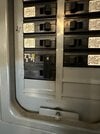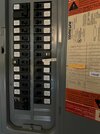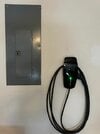Greetings!
I recently purchased the Tesla J1772 Wall Connector. It's mounted in the same spot that my Clipper Creek HDS-40 was located, less than 5 feet from my electric panel. At the time the Clipper Creek was installed, 2014, 40AMPS was considered a powerful EVSE and the electrician used #6 gauge three wire multi-strand for the connection. The wires are two white and one black. The second white wire is capped off in the panel and at the charger, unused.
When the new Tesla connector was installed it was connected to the 40AMP circuit and used the original wiring. A friend, who is a handyman and does electrical work as part of his craft installed the new Wall Connector for me. He is trained, but not a certified electrician, and after checking with SquareD told me that the wiring the powered my old EVSE could safely be used to upgrade to a 60AMP circuit with the Tesla Wall Connector.
The home electric panel is a SquareD box, as are all the circuit breakers. The Wall Connector is torqued to the specified spec, and after going through the registration process on my home WiFi everything is working fine. The car charges at 43-44 miles/hour, pulls 48 Amps, 11KW, and there doesn't seem to be any issue at all. The charging cable remains cool to the touch, and I don't have any concerns. I used the Tesla Authorization process to connect the Wall Connector, and it confirms it's connected to a 60 AMP circuit. When I charge is shows 48AMPs, 11KWh. No errors or problems during or after the authorization process.
A neighbor, a very hand guy, but with no formal electrical certification or training, was chatting with me and suggested that the wiring is incorrect. He said that there are several grades of #6 gauge wire and are rated for either 55/65/75 amp capacity. My original electrician stripped the sheathing during the installation so I can't confirm what AMP rating it may have. He's since retired and I can't reach him, but everything he did originally was to code.
I checked with a friend who services large telephone installations, and is very familiar with wiring and codes and works with electricians nearly every day. He came to my home and said I shouldn't be concerned, and that everything is fine. He checked the torque on all the electrical connections, and they are all to spec (he has the correct tools to do this). He also opened my panel and confirmed that the new 60AMP Square D circuit breaker is the correct model for the panel I own, and also confirmed that SquareD confirms that the panel is capable of accepting a 60AMP circuit breaker and is approved for wire of #6 gauge or heavier. He also confirmed that the actual run from the panel to the Wall Connector is about 6 feet.
Pictures are attached.
So, am I OK?
By the way the Wall Connector is a BIG upgrade from the Clipper Creek in every way, as it should be given the updated design. It charges both my Model Y and my wife's BMW 330e easily and without any issues. Naturally I would have preferred to get the newest Wall Connector announced today with an integrated NACS and J1772 combo connection, but I'm perfectly happy with the one I have. It would have been a nice feature to have the ability to open the Tesla charge port from the connecting plug, but the standard Tesla adapter works fine.
I recently purchased the Tesla J1772 Wall Connector. It's mounted in the same spot that my Clipper Creek HDS-40 was located, less than 5 feet from my electric panel. At the time the Clipper Creek was installed, 2014, 40AMPS was considered a powerful EVSE and the electrician used #6 gauge three wire multi-strand for the connection. The wires are two white and one black. The second white wire is capped off in the panel and at the charger, unused.
When the new Tesla connector was installed it was connected to the 40AMP circuit and used the original wiring. A friend, who is a handyman and does electrical work as part of his craft installed the new Wall Connector for me. He is trained, but not a certified electrician, and after checking with SquareD told me that the wiring the powered my old EVSE could safely be used to upgrade to a 60AMP circuit with the Tesla Wall Connector.
The home electric panel is a SquareD box, as are all the circuit breakers. The Wall Connector is torqued to the specified spec, and after going through the registration process on my home WiFi everything is working fine. The car charges at 43-44 miles/hour, pulls 48 Amps, 11KW, and there doesn't seem to be any issue at all. The charging cable remains cool to the touch, and I don't have any concerns. I used the Tesla Authorization process to connect the Wall Connector, and it confirms it's connected to a 60 AMP circuit. When I charge is shows 48AMPs, 11KWh. No errors or problems during or after the authorization process.
A neighbor, a very hand guy, but with no formal electrical certification or training, was chatting with me and suggested that the wiring is incorrect. He said that there are several grades of #6 gauge wire and are rated for either 55/65/75 amp capacity. My original electrician stripped the sheathing during the installation so I can't confirm what AMP rating it may have. He's since retired and I can't reach him, but everything he did originally was to code.
I checked with a friend who services large telephone installations, and is very familiar with wiring and codes and works with electricians nearly every day. He came to my home and said I shouldn't be concerned, and that everything is fine. He checked the torque on all the electrical connections, and they are all to spec (he has the correct tools to do this). He also opened my panel and confirmed that the new 60AMP Square D circuit breaker is the correct model for the panel I own, and also confirmed that SquareD confirms that the panel is capable of accepting a 60AMP circuit breaker and is approved for wire of #6 gauge or heavier. He also confirmed that the actual run from the panel to the Wall Connector is about 6 feet.
Pictures are attached.
So, am I OK?
By the way the Wall Connector is a BIG upgrade from the Clipper Creek in every way, as it should be given the updated design. It charges both my Model Y and my wife's BMW 330e easily and without any issues. Naturally I would have preferred to get the newest Wall Connector announced today with an integrated NACS and J1772 combo connection, but I'm perfectly happy with the one I have. It would have been a nice feature to have the ability to open the Tesla charge port from the connecting plug, but the standard Tesla adapter works fine.
Attachments
Last edited:





